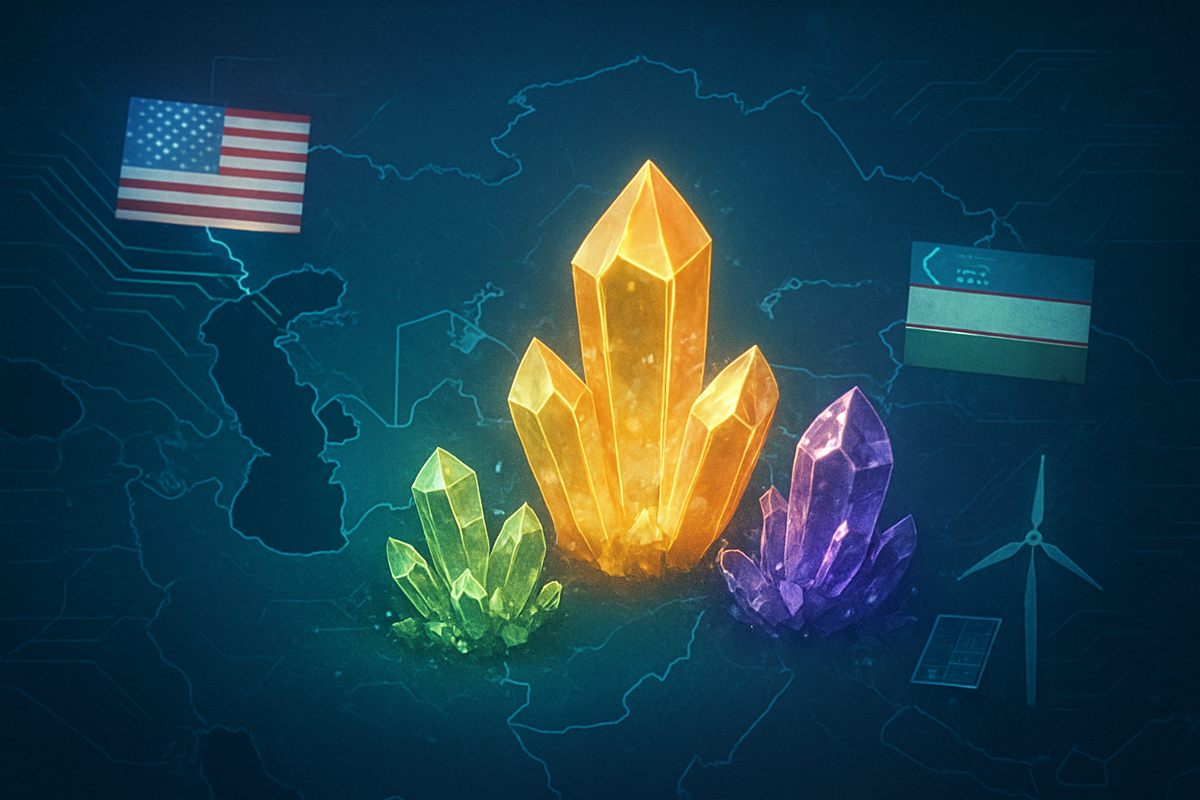
The United States is intensifying its diplomatic engagement in Central Asia, with a sharp focus on securing vital rare earth elements and critical minerals. This strategic pivot, highlighted by an unprecedented C5+1 summit in Washington on November 6, 2025, aims to dramatically diversify global supply chains and reduce an entrenched reliance on China, which currently dominates the rare earth market. The immediate implications are profound, promising to reshape the global landscape of critical mineral acquisition and bolstering Washington's geopolitical standing in a region historically influenced by Russia and China. This proactive stance underscores a pressing national security and economic imperative to fortify access to materials essential for advanced technologies, renewable energy, and defense.
Diplomatic Offensive Targets Critical Mineral Independence
The U.S. diplomatic push in Central Asia is a multi-pronged offensive designed to establish robust alternative supply chains for rare earth elements and other critical minerals. At the heart of this strategy is the C5+1 diplomatic forum, which brings together the United States and the five Central Asian republics: Kazakhstan, Kyrgyzstan, Tajikistan, Turkmenistan, and Uzbekistan. The upcoming November 6, 2025 summit in Washington, marking the first such gathering at the White House, is poised to be a pivotal moment, with critical minerals and rare earths high on the agenda. This follows preparatory visits by U.S. Special Envoy for South and Central Asia Sergio Gor and Deputy Secretary of State Christopher Landau to Uzbekistan and Kazakhstan, where "critical materials" were a central discussion point.
A significant development in this evolving narrative is the memorandum of understanding on critical minerals cooperation signed between Uzbekistan and the U.S. in September 2024, signaling a deepening bilateral commitment. Beyond rare earths, the U.S. is also actively facilitating a private American bid by Cove Kaz Capital Group LLC for Kazakhstan's substantial Upper Kairakty and North Katpar tungsten deposits. This move directly challenges state-backed Chinese bidders, illustrating the broader U.S. strategy to compete for crucial raw materials. The U.S. International Development Finance Corporation (DFC) has also expressed interest in co-financing midstream mining and processing infrastructure in Central Asia, indicating a commitment to developing not just extraction but also crucial processing capabilities within the region. This focus on midstream development is critical, as China's dominance extends beyond mining to an estimated 90% of global processing capacity.
The urgency of these efforts is underscored by China's near-monopoly on rare earth elements and its historical willingness to use export controls as a geopolitical tool. While a "tactical pause" on some Chinese rare earth export curbs was agreed upon in October 2025 following a meeting between U.S. President Trump and Chinese President Xi Jinping, this agreement is set to expire in 2026. This looming deadline intensifies the need for the U.S. to rapidly secure alternative sources. Central Asian nations, particularly Kazakhstan and Uzbekistan, possess significant, largely underdeveloped reserves of rare earths and other critical minerals, offering a crucial opportunity for Western investment and technology to unlock their potential. The immediate industry reaction has been one of cautious optimism, with mining and technology sectors keenly observing the progress of these diplomatic initiatives as they seek greater supply chain predictability.
Companies Poised to Win or Lose in the Critical Minerals Race
The U.S.'s intensified rare earth diplomacy in Central Asia is set to create significant winners and losers across the global mining, technology, and defense sectors. Companies with expertise in exploration, extraction, processing, and refining of critical minerals, particularly those with existing operations or strategic interests in Central Asia, stand to gain substantially. Conversely, companies heavily reliant on single-source supply chains, especially those tied to Chinese rare earth imports, may face increased pressure to diversify or risk supply disruptions and higher costs.
Among the potential beneficiaries, Cove Kaz Capital Group LLC is a private American entity already making moves, actively bidding for significant tungsten deposits in Kazakhstan. While tungsten is a critical raw material rather than a rare earth, this signals a broader intent for U.S. private sector engagement in the region's mineral wealth. Publicly traded companies specializing in rare earth and critical mineral exploration and processing, such as MP Materials (NYSE: MP), which operates the Mountain Pass mine in California, could see indirect benefits from a more diversified global supply chain. While MP Materials focuses on domestic production, a global push for diversification could stabilize prices and encourage broader investment in non-Chinese processing technologies, from which MP Materials could indirectly benefit through technological advancements or partnership opportunities. Similarly, other Western mining companies like Rio Tinto (ASX: RIO) or BHP Group (ASX: BHP), known for their vast global operations, might explore new ventures or partnerships in Central Asia if the U.S. diplomatic efforts successfully de-risk the investment environment and provide attractive incentives for developing these untapped reserves.
On the losing side, Chinese state-backed mining and processing entities, which have historically dominated the Central Asian critical minerals landscape, could see their influence wane. Companies like China Minmetals Corporation or Ganfeng Lithium (SHE: 002460), while diversified, could face increased competition for new projects and potentially reduced market share in regions where the U.S. is actively promoting alternatives. Furthermore, Western manufacturers of electric vehicles, defense systems, and high-tech electronics, such as Tesla (NASDAQ: TSLA), Lockheed Martin (NYSE: LMT), or Apple (NASDAQ: AAPL), which currently rely on Chinese-processed rare earths for components, face a crucial juncture. While diversification offers long-term stability, the immediate transition could involve higher initial costs or the need to re-engineer supply chains, posing short-term challenges. However, in the long run, a more resilient and geographically diverse supply chain would ultimately benefit these companies by mitigating geopolitical risks and ensuring consistent access to essential materials.
Geopolitical Chessboard: Broader Implications and Strategic Shifts
The U.S. rare earth diplomacy in Central Asia is more than just a quest for minerals; it's a strategic maneuver on a complex geopolitical chessboard, reflecting broader industry trends and significant policy implications. This initiative fits squarely within a global push by Western nations to "de-risk" their supply chains from over-reliance on single countries, particularly China. The COVID-19 pandemic and subsequent geopolitical tensions have starkly highlighted the vulnerabilities of highly concentrated supply chains, accelerating the drive for diversification across various critical sectors, from semiconductors to pharmaceuticals and, crucially, critical minerals.
The potential ripple effects on competitors and partners are substantial. For China, a successful U.S. pivot to Central Asian rare earths could erode its near-monopoly, forcing it to recalibrate its own Belt and Road Initiative (BRI) investments in the region, which have often focused on infrastructure linked to resource extraction. For Russia, whose influence in Central Asia has historically been paramount, increased U.S. engagement in a strategic sector like critical minerals could further diminish its regional sway, especially in the wake of its full-scale invasion of Ukraine, which has prompted Central Asian states to seek greater economic and political independence. For U.S. allies in Europe and Asia, this initiative could pave the way for collaborative investment and shared access to diversified rare earth sources, strengthening collective economic security.
Regulatory and policy implications are also significant. The U.S. government is likely to leverage tools such as the Defense Production Act, the U.S. International Development Finance Corporation (DFC), and various trade incentives to encourage private sector investment in Central Asian mining and processing. There could also be increased pressure on multinational corporations to audit their supply chains for ethical sourcing and environmental compliance, aligning with Western standards. Historically, resource diplomacy has often been a tool of great power competition, with precedents ranging from the "Great Game" in Central Asia to the scramble for oil in the Middle East. This current initiative draws parallels to past efforts to secure strategic resources, but with a modern twist: focusing on the digital and green economy's foundational elements rather than just fossil fuels. The U.S. strategy aims to learn from past mistakes by emphasizing transparent, value-added partnerships rather than purely extractive relationships, seeking to engage Central Asian nations as partners in processing and refining, not just as raw material suppliers.
The Road Ahead: Opportunities, Challenges, and Emerging Scenarios
The U.S. rare earth diplomacy in Central Asia sets the stage for a dynamic period, presenting both significant opportunities and formidable challenges in the short and long term. In the short term, the immediate focus will be on the outcomes of the November 6, 2025 C5+1 summit and the subsequent bilateral agreements. Success here could rapidly de-risk initial investments, leading to an uptick in geological surveys and feasibility studies by Western mining companies in Kazakhstan, Uzbekistan, and potentially other Central Asian nations. This could quickly translate into new exploration licenses and early-stage project development, signaling a tangible shift in investment flows.
Looking further ahead, the long-term possibilities involve the establishment of fully integrated rare earth supply chains outside of China, stretching from Central Asian mines to processing facilities and ultimately to Western manufacturing hubs. This would require substantial, sustained investment in infrastructure, technology transfer, and workforce development within Central Asia. Market opportunities will emerge for companies specializing in advanced mining technologies, mineral processing, environmental remediation, and logistics. Furthermore, the development of midstream processing capabilities in Central Asia could foster local industrial growth, creating jobs and diversifying the economies of these nations beyond traditional energy exports.
However, significant challenges loom. Geopolitical complexities, including navigating the established influence of Russia and China in the region, will require delicate diplomacy. Investment security, regulatory stability, and combating corruption in Central Asian states will be crucial for attracting and retaining Western capital. Environmental and social governance (ESG) standards will also be under scrutiny, requiring transparent and responsible mining practices. Potential strategic pivots could involve greater collaboration with allies like Japan, South Korea, and the European Union, pooling resources and expertise to accelerate diversification efforts. Emerging market opportunities could also extend to associated industries, such as renewable energy infrastructure development, as securing critical minerals is often intertwined with the broader energy transition. Potential scenarios range from a gradual but steady diversification of rare earth supplies, leading to a more balanced global market, to a more aggressive, rapid shift that could trigger competitive responses from existing dominant players. Investors should watch for the signing of concrete investment agreements, the formation of joint ventures, and any legislative changes in Central Asia aimed at attracting foreign direct investment in the mining sector.
A New Dawn for Critical Mineral Security
The U.S. rare earth diplomacy in Central Asia marks a pivotal moment in the global race for critical mineral security, signifying a determined effort to recalibrate supply chains and bolster national economic and strategic interests. The key takeaway is clear: the United States is actively pursuing tangible alternatives to its reliance on Chinese rare earth elements, leveraging diplomatic forums like the C5+1 and targeted investment initiatives. This strategy is driven by the urgent need to secure materials essential for advanced technologies and national defense, especially as the "tactical pause" on some Chinese rare earth export curbs approaches its 2026 expiration.
Moving forward, the market is poised for significant shifts. While China will undoubtedly remain a major player, the emergence of Central Asia as a viable source could introduce greater competition and resilience into the global rare earth market. This could lead to a more diversified and potentially stable pricing environment for these crucial materials, benefiting industries from electric vehicles to defense. The lasting impact of this initiative could be the fundamental reshaping of global resource geopolitics, fostering new alliances and economic corridors that reduce single-point vulnerabilities.
Investors should closely monitor several key indicators in the coming months. These include the specifics of any deals emerging from the C5+1 summit, announcements of new U.S. private sector investments in Central Asian mining and processing projects, and any legislative or regulatory reforms within Central Asian nations designed to attract and protect foreign capital in the critical minerals sector. Furthermore, tracking the responses from China and Russia to this increased U.S. engagement will be crucial for understanding the evolving geopolitical landscape. The success of this diplomatic offensive could usher in a new era of critical mineral security, but its execution will require sustained political will, significant financial commitment, and astute navigation of complex regional dynamics.
This content is intended for informational purposes only and is not financial advice





